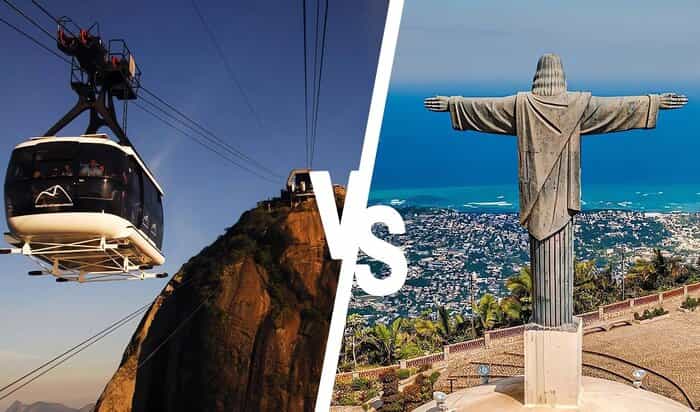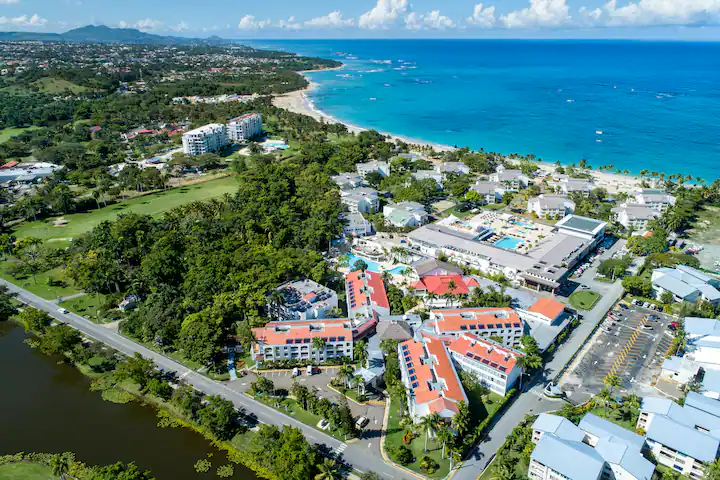Did you know that there are 2 cable cars with Christ the Redeemer around the world?
Teleférico del Pan De Azucar VS Teleférico de Puerto Plata
The only 2 cable cars with Christ the Redeemer of the Caribbean and the world
1- THE HISTORY OF THE SUGAR LOAF CABLE CAR IN RIO DE JANEIRO
The original 'bondinho' was inaugurated on October 27, 1912
1 / 4
SUGAR LOAF CABLE CAR
The Sugar Loaf cable car was designed in 1909 by engineer Augusto Ferreira Ramos and took three years to complete.
2 / 4
SUGAR LOAF CABLE CAR
The Sugar Loaf cable car ascends to the top of the Sugar Loaf hill.
3 / 4
SUGAR LOAF CABLE CAR
The Sugar Loaf cable car was inaugurated on October 27, 1912.
4 / 4
RIO DE JANEIRO
Panoramic view of Rio de Janeiro, with the Sugar Loaf hill in the center.
The cable car that reaches the top of Sugar Loaf is one of the most spectacular in the world. This granite and quartz monolith, located at the mouth of Guanabara Bay, in Rio de Janeiro (Brazil), is 396 meters high and offers one of the best views of the Marvelous City. The Sugar Loaf Bondinho runs along two routes, connecting Praia Vermelha in a first section with the top of Urca Hill, 220 meters above sea level, and from there to the Sugar Loaf.
The original cable car was designed in 1909 by the Brazilian engineer Augusto Ferreira (1860-1939). The work took three years to complete and required a large team of Brazilian and Portuguese operators, who used equipment imported from Germany to raise Brazil's first cable car. On October 27, 1912, it made its inaugural trip, transporting 577 people that day from the beach to the summit of Urca, in a journey of just over 500 meters and lasting six minutes. On January 18, 1913, the second section was completed, up to the peak of Pan de Azúcar. The cabin was made of wood and had a capacity for 17 people.
The current cable car, larger and more modern, was built in the early 1970s and opened on October 29, 1972.
2- THE HISTORY OF THE PUERTO PLATA CABLE CAR, DOMINICAN REPUBLIC.
The 'Puerto Plata Cable Car' was inaugurated on July 19, 1975.
In 1970, on the “Isabel de Torres” Mountain, at the top of the fortress, “El Cristo Redentor” was installed, with a view to greater tourist attraction. In June 1971, the highway from El Cupey to the top of the mountain and was built with the purpose of facilitating and helping to mobilize the machinery or equipment destined for the construction of the Cable Car.
The Dominican Government signed with the Italian company Ceretti e Tanfani for the supply of the equipment that would later be installed in the Cable Car, starting the civil works in 1972.
The Funicular is installed on Loma Isabel de Torres in the city, it is of the “come and go” type, and consists of three cables on each side, two cabins, two stations and a cable support tower.
In 1973 the Botanical Garden, the gardens and the fountains were built.
At the end of 1974 all the equipment was installed and the test trips were being made, for that test there was a duration of six months.
The installation of the Cable Car, which was basically a tourist attraction, has given results to the city of Puerto Plata and the country, as it is the only Cable Car in the Caribbean, and has been visited by tourists from all continents.
Upon reaching the upper base, there are 2 names embroidered in flowers that represent the initials of the Catholic Monarchs of Spain, Fernando and Isabel (symbol of the Colonization of America), this symbol represents the city of Puerto Plata.
This attraction gives us great importance as a country, due to its exotic natural beauty and its extensive National Park, which with its greenery blends with the sea and makes it even more beautiful, from the Cable Car we can see the majestic contrast.
The dome that we know as the base where today the statue of Christ the Redeemer stands on the Isabel de Torres hill, is actually a fortress, or rather it was built for that purpose: an anti-aircraft fortress for some and a 'pill box' (Pill Box) for others. Built by Trujillo to protect the city from possible foreign incursions.
The loopholes were equipped with anti-aircraft artillery, from the different flanks. On the surface where the statue of Christ stands today, there was a hexagonal gate through which, from the inside, a cannon or some weapon capable of counteracting attacks of different types, sea, air or land, was removed; In addition, due to the panoramic view that it dominated, it made it perfect for surveillance of the entire coastline.
Strategically, the fortress was covered with herbs, so that, due to its dome shape, it was mistaken for a hill. But I am inoperative. Given the circumstances of the climate that prevails in that environment, the degree of continuous cloud cover did not allow visibility and constant surveillance.
The architect Cristian Martínez was the one who presented the idea of installing a funicular to ascend to the top of the hill, and in 1972 the then president, Dr. Balaguer, gave the order for construction work to begin. A year later, the Italian company Cerretti Tanfani began the installation of the Puerto Plata cable car, finishing the work in 1974.
After six months of tests, on July 19, 1975 the work was opened to the public, and that same year it was inaugurated.
By 1973, the engineer Benjamin Paewonsky was commissioned to convert the entire area of the top into a botanical garden.
- FAQ's
¿How long does it take to climb Sugar Loaf?
Bear in mind that the ascent to the Sugar Loaf takes approximately 2 hours, therefore, as we mentioned before, if you want to enjoy the sunset, do not forget to take this waiting time into account so as not to miss the main show. It may interest you: Travel to Brazil – Travel Guide.
¿How much does it cost to enter Sugar Loaf?
The cable car that reaches the summit of Sugar Loaf is one of the most spectacular in the world. This granite and quartz monolith, located at the mouth of Guanabara Bay, in Rio de Janeiro (Brazil), is 396 meters high and offers one of the best views of the Marvelous City.
Why is it called Sugarloaf?
Due to its resemblance to a sugar loaf cone, the first Portuguese explorers who discovered Rio de Janeiro in 1502 called it the Sugar Loaf, today one of the main tourist attractions in the city.
¿How big is the cross located on the Cerro Pan de Azúcar?
¿What does the cross of the hill mean?
A summit cross is a cross used to mark the summit of a mountain or hill.
¿Where to buy Sugar Loaf tickets?
Sugar Loaf Cable Car Ticket Office, Pasteur Avenue, 520 - Urca, Rio de Janeiro 22290-240.











